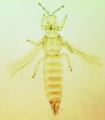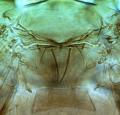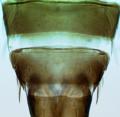Frankliniella tritici
Recognition data
Distinguishing features
Both sexes fully winged. Color of body and legs variable, either yellow with dark setae, or brown; antennal segments VI–VIII brown, also distal half of IV; fore wing pale with dark setae. Head wider than long; three pairs of ocellar setae present, pair III arising on anterior margins of ocellar triangle but scarcely as long as distance between hind ocelli; postocular setae pair I present, pair IV slightly longer than diameter of one hind ocellus. Antennae 8-segmented; segments III–IV with sensorium forked, pedicel of segment III slightly swollen, VIII not longer than VII. Pronotum with 5 pairs of major setae; anteromarginal setae shorter than anteroangulars, one pair of minor setae present medially between posteromarginal submedian setae. Metanotum with 2 pairs of setae at anterior margin, campaniform sensilla present. Fore wing with two complete rows of veinal setae. Abdominal tergites V–VIII with paired ctenidia, on VIII anterolateral to spiracle; tergite VIII posteromarginal comb absent medially but with slender teeth laterally. Sternites III–VII without discal setae.
Male smaller than female; sternites III–VII with small oval pore plate.
Variation
Adults from populations in the southern part of the range of this species, in eastern and coastal USA (Florida, Georgia), are usually yellow, but adults from populations further north west are often dark brown. The possibility of a cline, or of a pair of sibling species, requires further investigation. F. varicorne Bagnall is an available name for these darker populations.
Related and similar species
F. tritici is one of a group of Frankliniella species in which the pedicel of antennal segment III is swollen, or enlarged in some way. Currently 230 species are listed in the genus Frankliniella, with up to 130 further names placed into synonymy (Nakahara, 1997). This high rate of synonymy has been due to unrecognized variability in size and color of so many species. Scarcely ten of these species are native to parts of the world other than the Americas.
Taxonomic data
Current valid name
Frankliniella tritici (Fitch)
Original name and synonyms
- Thrips tritici Fitch, 1855: 385
- Frankliniella varicorne Bagnall, 1919: 268
- Frankliniella fulvus Moulton, 1936: 61
- Frankliniella tritici f. clara Moulton, 1948: 87
- Frankliniella salicis Moulton, 1948: 104
Family placement
Thripidae, Thripinae
Common names
Eastern flower thrips
Biological data
Life history
Breeding in flowers and possibly on leaves.
Host plants
Associated with a wide range of species of flowering plants.
Tospoviruses vectored
None
Crop damage
Involved in damage to various field crops, but particularly roses.
Distribution data
Area of origin
Eastern USA
Distribution
Widespread in North America; records from other countries require further confirmation.







